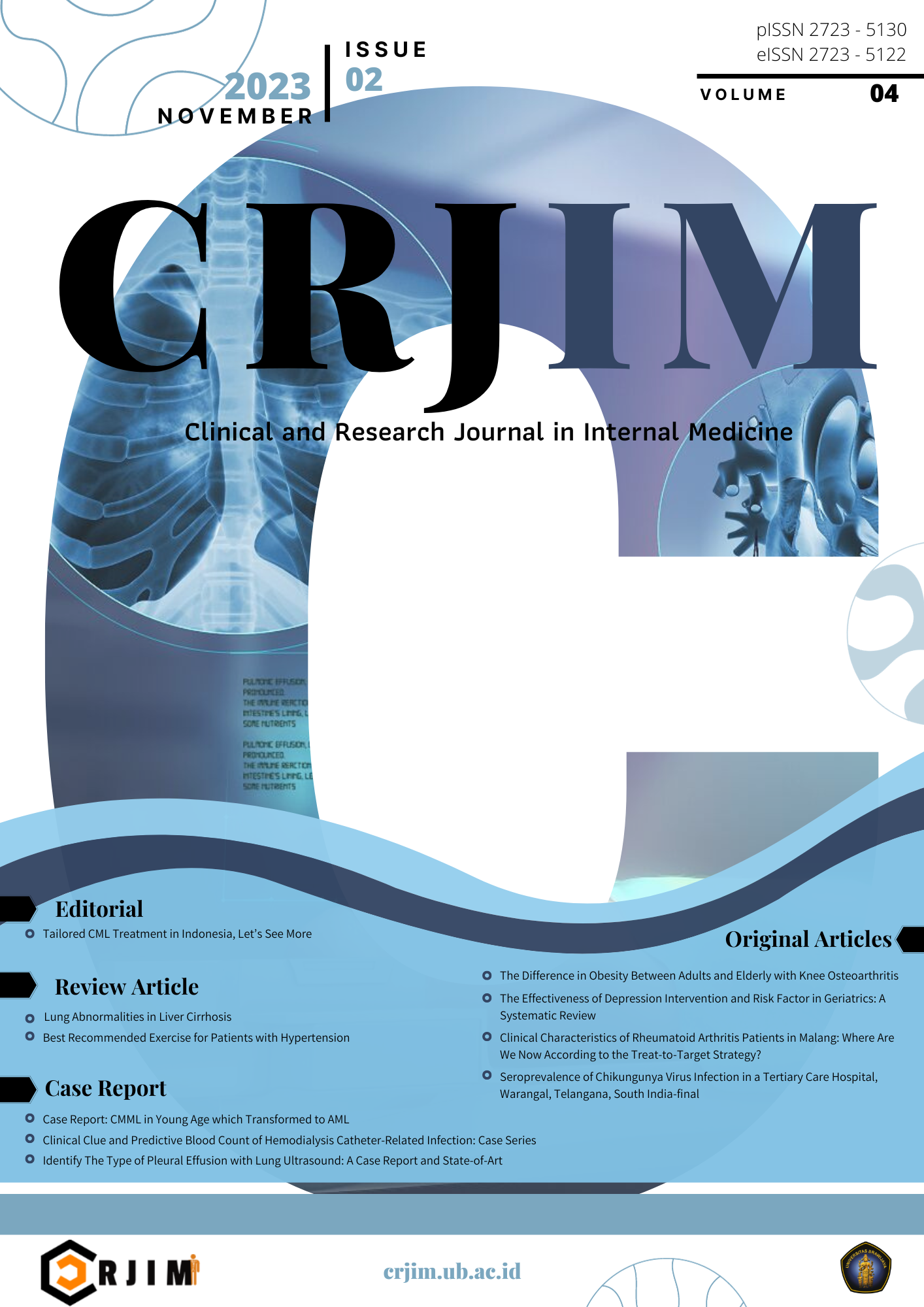Lean Non-Alcoholic Fatty Liver Disease (NAFLD)
DOI:
https://doi.org/10.21776/ub.crjim.2020.001.01.6Keywords:
NAFLD, Lean NLFDAbstract
Non-Alcoholic Fatty Liver Disease (NAFLD) is a condition that can develop into advanced liver disease. The NAFLD spectrum includes simple steatosis, non-alcoholic steatohepatitis (NASH), liver fibrosis, and liver cirrhosis to hepatocellular carcinoma. One of the underlying pathophysiologies is insulin resistance found in metabolic syndrome. People with metabolic syndrome are not always obese, and NAFLD can also be found in this group, known as lean NAFLD, which has different metabolic characteristics. Metabolic characteristics of lean NAFLD include high levels of transaminases and insulin, low insulin sensitivity, low fasting glucose, low necroinflammatory activity, and liver fibrosis. Some related factors are methionine and choline deficiency, excessive acyl-coA expression, and PNPLA3 gene polymorphism. Lean NAFLD is an interesting topic to discuss because practitioners' awareness of lean NAFLD is lower compared to obese patients. NAFLD is a risk factor for chronic diseases such as cardiovascular disease, kidney disease, colorectal, atrial fibrillation, and hypothyroidism, so it is essential to be recognized by clinicians. To date, there are no guidelines or recommendations that discuss specific treatments in this lean NAFLD population.
Â
Â
References
Hashimoto E, Taniai M, Tokushige K. Characteristics and diagnosis of NAFLD/NASH. J Gastroenterol Hepatol. 2013; 28 Suppl 4: 64-70. [PMID: 24251707 DOI: 10.1111/jgh.12271]
Choi JH, Rhee EJ, Bae JC et al. Increased Risk of Type 2 Diabetes in Subjects with Both Elevated Liver Enzymes and Ultrasonographically Diagnosed Nonalcoholic Fatty Liver Disease: A 4-year Longitudinal Study. Elsevier. 2013; Volume 44, Issue 2: 115-120. [DOI: 10.1016/j.arcmed.2013.01.007]
Vos B, Moreno C, Nagy N et al. Lean Non-Alcoholic Fatty Liver Disease (Lean-NAFLD): a major cause of cryptogenic liver disease. Acta Gastroenterol Belg. 2011; 74: 389-394. [PMID: 22103042]
Margariti E, Deutsch M, Manolakopoulos S, George V. P. Nonalcoholic Fatty Liver Disease May Develop in Individuals with Normal Body Mass Index. Ann Gastroenterol. 2012; 25(1): 45–51. [PMID: 24713801]
Kim HJ, Lee KE, Kim DJ et al. Metabolic Significance of Non-alcoholic Fatty Liver Disease in Nonobese, Nondiabetic Adults. Arch Intern, Med. 2004; 164: 2169-2175. [PMID: 15505132 DOI: 10.1001/archinte.164.19.2169]
Das UN. Metabolic Syndrome X Is Common in South Asians, But Why and How? Nutrition. 2002; 18: 774-776. [PMID: 12297221 DOI: 10.1016/S0899-9007(02)00826-2]
Feng RN, Du SS, Wang C et al. Lean-Non-Alcoholic Fatty Liver Disease Increases Risk for Metabolic Disorders in A Normal Weight Chinese Population. World J Gastroenterol. 2014; 20(47): 17932-17940. [PMID: 12297221 DOI: 10.1016/s0899-9007(02)00826-2]
Chalasani N, Younossi Z, Lavine JE et al. The Diagnosis and Management of Non-Alcoholic Fatty Liver Disease: Practice Guideline by the American Association for the Study of Liver Diseases, American College of Gastroenterology, and the American Gastroenterological Association. Hepatology. 2012; 55(6):2005-2018. [PMID: 22488764 DOI: 10.1002/hep.25762]
Jian-gao F. Guidelines for Management of Non-Alcoholic Fatty Liver Disease: an updated and revised Edition. Zhonghua Ganzangbing Zazhi. 2010; 18: 163-166. [PMID: 20698076]
Oniki K, Saruwatari J, Izuka T et al. Influence of the PNPLA3 rs738409 Polymorphism on Non-Alcoholic Fatty Liver Disease and Renal Function among Normal Weight Subjects. PLoS ONE. 2015; 10(7): e0132640. [DOI: 10.1371/journal.pone.0132640]
Hasan I, Gani RA, Machmud R et al. Prevalence and Risk Factors for Non-Alcoholic Fatty Liver in Indonesia. J Gastroenterol Hepatol 2002; 17(Suppl.): S154.
Sasdesi LES, Purnomo HD. Data Kunjungan Pemeriksaan Ultrasonografi Abdomen Instalasi Radiologi RSUP Dr. Kariadi Semarang; 2010.
Nishioji K, Sumida Y, Kamaguchi M, Mochizuki N et al. Prevalence Of And Risk Factors For Non-Alcoholic Fatty Liver Disease In A Non-Obese Japanese Population, 2011-2012. JGHF 2015; 50(1):95-108. [DOI: 10.1007/s00535-014-0948-9]
Hasan I. Perlemakan Hati Non-Alkoholik. In: Sulaiman A, Akbar N, Lesmana LA, Noer HMS (Eds). Buku Ajar Ilmu Penyakit Hati. Jakarta: Jaya Abadi 2007:695-700.
Takaki A, Kawai D, Yamamoto K. Multiple Hits, Including Oxidative Stress, as Pathogenesis and Treatment Target in Non-Alcoholic Steatohepatitis (NASH). Int. J. Mol. Sci. 2013; 14:20704-20728. [doi:10.3390/ijms141020704]
Anstee QM. Animal Models in Non-Alcoholic Steatohepatitis Research: Utility and Clinical Translation. Liver Int. 2011; 31:440-442. [PMID: 21382155 DOI: 10.1111/j.1478-3231.2011. 02463.x]
Hebbard L, George J. Animal Models of Non-Alcoholic Fatty Liver Disease. Nat Rev Gastroenterol Hepatol. 2011; 8:35-44. [PMID: 21119613 DOI: 10.1038/nrgastro.2010.191]
Monetti M, Levin MC, Watt MJ et al. Dissociation of Hepatic Steatosis and Insulin Resistance in Mice Overexpressing DGAT In the Liver. Cell Metab. 2007; 6:69-78. [PMID: 17618857 DOI: 10.1016/j.cmet.2007.05.005]
Romeo S, Huang-Doran I, Baroni MG, Kotronen A. Unravelling the Pathogenesis of Fatty Liver Disease: Patatin-Like Phospholipase Domain-Containing 3 Protein. Curr Opin Lipidol. 2010; 21:247-252. [PMID: 20480550]
Visser ME, Lammers NM, Nederveen AJ, et al. Hepatic Steatosis Does Not Cause Insulin Resistance in People with Familial Hypobetalipoproteinaemia. Diabetologia. 2011; 54:2113-2121. [PMID: 21547498 DOI: 10.1007/s00125-011-2157-x]
Saida T, Fukushima W, Ohfuji S, Kondo K, Matsunaga I, Hirota Y. Effect Modification of Body Mass Index and Body Fat Percentage on Fatty Liver Disease in A Japanese Population. J Gastroenterol Hepatol. 2014; 29(1):128-36. [DOI:10.1111/jgh.12377]
Bhat G, Baba CS, Pandey A, Kumari N, Choudhuri G. Insulin Resistance, and Metabolic Syndrome in Nonobese Indian Patients with Non-Alcoholic Fatty Liver Disease. Tropical Gastroenterology. 2013; 34(1):18 –24. [DOI: 10.7869/tg.2012.86]
Hernaez R, Lazo M, Bonekamp S et al. Diagnostic Accuracy and Reliability of Ultrasonography for The Detection of Fatty Liver: A Meta-Analysis. Hepatology. 2012; 54(3):1082-1090 [doi: 10.1002/hep.24452]
WHO Expert Consultation. Appropriate Body-Mass Index for Asian Populations and Its Implications for Policy and Intervention Strategies. Lancet. 2004; 363: 157–163. [PMID: 14726171]



















